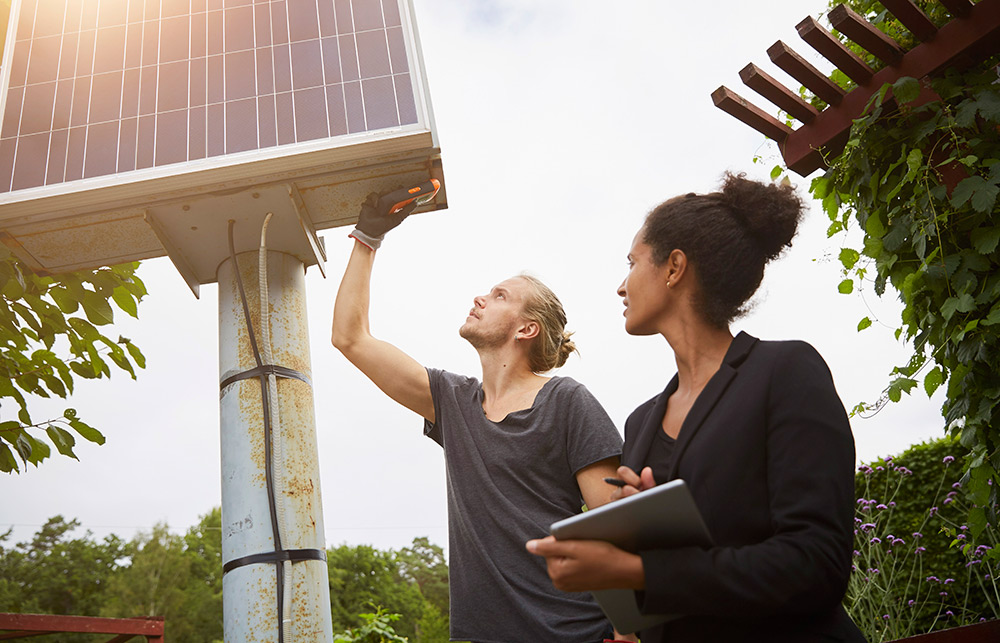推进能源体系清洁化,是重振美国经济的法宝

受新冠肺炎疫情影响,美国的失业率已经上升至“大萧条”时代以来的最高水平。在“后疫情时代”,很多工作岗位将永远消失,还有一些就业岗位可能需要几年的时间才能恢复到正常水平。不过有危必有机。现在,我们有一个千载难逢的机会来解决当前的经济危机——推动能源向清洁能源转型。
根据非盈利机构Rewiring America最近的一项研究估计,如果美国的能源体系由化石能源转向电能,那么到2035年,美国经济将新增2500万个就业岗位。这个结果是两名笔者与麻省理工学院的工程师山姆·卡利奇对能源、劳动力和材料等领域的复杂数据进行了深入的能源分析和工程分析后得出的。我们非常清楚地知道,我们目前的能源来自哪里,我们的能源使用量是多少,我们需要怎样建设,才能将现有能源体系转型成一个零排放的能源体系,以及我们到底需要多少人来生产转型所需的相关产品和设备。
简而言之,清洁能源技术在制造、安装和维护方面,比化石能源技术需要更多的劳动力。举个简单的例子,在能源产出相等的前提下,要安装和维护一座风力发电厂,需要的人肯定比打一口油井以及维护这口油井的人多。所有这些工作都具有倍增效应——安装风力发电设施的妇女将获得一份丰厚的收入,这些收入又能带入当地经济,促进当地餐饮、商店和其他被疫情重创的企业的复苏。
在不依赖化石能源的前提下,要想继续保持目前的生活舒适水准(比如汽车、房屋供暖以及其他家电设备),美国的发电能力必须达到1500千兆瓦,也就是美国目前发电量的三倍多。这么大规模的能源电力化工程,是美国近几十年来的所有建设项目均无法比拟的。我们至少需要几十万个风力涡轮机、600万辆零排放卡车、100万英里的传送线缆、几亿辆电动汽车、不计其数的热泵和电动感应装置,以及几十上百亿块太阳能发电板和超过一万亿块电池。而且,我们还需要几千万个工作岗位来生产、建设、安装和管理所有这些东西。
到时候,全国各地都会有与清洁能源相关的工作岗位,因为我们需要有人在房顶上安装太阳能电板,有人在田野里安装风力发电机。这些工作是无法外包给其他国家的,只能由本地人来做。因此,受疫情重创的人们将有机会找到新的好工作,同时也能帮助所在社区获得更清洁和更安全的能源。
我们已经有了能让美国实现电力化的技术方案,但我们也需要新的政策和资金。能源体系的清洁化转型需要更高的前期成本,需要建设新的分布更广的电力基础设施。这些基础设施很多都是属于私人的——比如你屋顶上的太阳能电板和你车库里的电动汽车,所以我们也需要一些低成本的融资来促进能源转型。
在“大萧条”之后,美国推出了罗斯福新政,其中包括一系列就业计划和金融创新,它们为一些美国人提供了购买房屋和电器的机会,也让一些人的生活稳定了下来。不过当时,美国的黑人仍然没有权利申请联邦抵押贷款。今天,我们可以向老百姓提供更广泛、更公平的“气候贷款”,让所有人的能源从“烧油”变成“烧电”。
那么,这一切的代价是什么呢?有了适当的融资,这个就业解决方案不会花费普通美国老百姓的任何前期投资。此外,只要新的基础设施建立起来了,可再生的电能将会非常便宜——毕竟阳光和风都是大自然免费的馈赠。估计美国每个家庭每年平均可以省下2000美元的电费。这对低收入人群是一个巨大的实惠,而他们也是受能源价格波动影响最大的群体。而当能源便宜了,一切也就便宜了。
除了明智的融资政策,我们还需要在监管方面进行改革,修订建筑领域的法律法规,便利能源的电力化和太阳能发电设施的安装。为了使这个系统顺利运行,我们还需要做到“电网中立”,使每个人都可以自由和民主地交换能源,就像我们在互联网上交换信息一样。
要实现这个目标,就需要政府进行一次具有历史意义的动员和投资,但美国以前就曾这样做过。比如在二战期间,为了对抗希特勒,拯救西方民主制度,美国必须迅速扩充军备,当时,美国向转型生产军火的企业提供了大量资本,并担保这些企业能获得7%的利润,这也就是所谓“爱国的7%”。这个策略取得了成功。在“大萧条”最严峻的时候,美国的失业率超过了24%。而到了1944年,凭借美国的战时生产体制,美国的失业率降到了1.2%。我们估计,美国向零排放经济转型的成本,至少比二战期间“全民造军火”的成本要低。
现在,就像二战和“大萧条”时期一样,我们也有了一个走出危机的难得的机会。而且我们还有机会战胜疫情这个致命威胁,为未来重建一个更清洁、更繁荣的国家。(财富中文网)
本文作者索尔·格里菲斯是一名工程师、物理学家和麦克阿瑟“天才奖”研究员。另一作者亚力克斯·拉斯基是一位清洁能源领域的创业者,也是Opower公司创始人。他们也是非盈利机构Rewiring America的联合创始人。
译者:隋远洙
受新冠肺炎疫情影响,美国的失业率已经上升至“大萧条”时代以来的最高水平。在“后疫情时代”,很多工作岗位将永远消失,还有一些就业岗位可能需要几年的时间才能恢复到正常水平。不过有危必有机。现在,我们有一个千载难逢的机会来解决当前的经济危机——推动能源向清洁能源转型。
根据非盈利机构Rewiring America最近的一项研究估计,如果美国的能源体系由化石能源转向电能,那么到2035年,美国经济将新增2500万个就业岗位。这个结果是两名笔者与麻省理工学院的工程师山姆·卡利奇对能源、劳动力和材料等领域的复杂数据进行了深入的能源分析和工程分析后得出的。我们非常清楚地知道,我们目前的能源来自哪里,我们的能源使用量是多少,我们需要怎样建设,才能将现有能源体系转型成一个零排放的能源体系,以及我们到底需要多少人来生产转型所需的相关产品和设备。
简而言之,清洁能源技术在制造、安装和维护方面,比化石能源技术需要更多的劳动力。举个简单的例子,在能源产出相等的前提下,要安装和维护一座风力发电厂,需要的人肯定比打一口油井以及维护这口油井的人多。所有这些工作都具有倍增效应——安装风力发电设施的妇女将获得一份丰厚的收入,这些收入又能带入当地经济,促进当地餐饮、商店和其他被疫情重创的企业的复苏。
在不依赖化石能源的前提下,要想继续保持目前的生活舒适水准(比如汽车、房屋供暖以及其他家电设备),美国的发电能力必须达到1500千兆瓦,也就是美国目前发电量的三倍多。这么大规模的能源电力化工程,是美国近几十年来的所有建设项目均无法比拟的。我们至少需要几十万个风力涡轮机、600万辆零排放卡车、100万英里的传送线缆、几亿辆电动汽车、不计其数的热泵和电动感应装置,以及几十上百亿块太阳能发电板和超过一万亿块电池。而且,我们还需要几千万个工作岗位来生产、建设、安装和管理所有这些东西。
到时候,全国各地都会有与清洁能源相关的工作岗位,因为我们需要有人在房顶上安装太阳能电板,有人在田野里安装风力发电机。这些工作是无法外包给其他国家的,只能由本地人来做。因此,受疫情重创的人们将有机会找到新的好工作,同时也能帮助所在社区获得更清洁和更安全的能源。
我们已经有了能让美国实现电力化的技术方案,但我们也需要新的政策和资金。能源体系的清洁化转型需要更高的前期成本,需要建设新的分布更广的电力基础设施。这些基础设施很多都是属于私人的——比如你屋顶上的太阳能电板和你车库里的电动汽车,所以我们也需要一些低成本的融资来促进能源转型。
在“大萧条”之后,美国推出了罗斯福新政,其中包括一系列就业计划和金融创新,它们为一些美国人提供了购买房屋和电器的机会,也让一些人的生活稳定了下来。不过当时,美国的黑人仍然没有权利申请联邦抵押贷款。今天,我们可以向老百姓提供更广泛、更公平的“气候贷款”,让所有人的能源从“烧油”变成“烧电”。
那么,这一切的代价是什么呢?有了适当的融资,这个就业解决方案不会花费普通美国老百姓的任何前期投资。此外,只要新的基础设施建立起来了,可再生的电能将会非常便宜——毕竟阳光和风都是大自然免费的馈赠。估计美国每个家庭每年平均可以省下2000美元的电费。这对低收入人群是一个巨大的实惠,而他们也是受能源价格波动影响最大的群体。而当能源便宜了,一切也就便宜了。
除了明智的融资政策,我们还需要在监管方面进行改革,修订建筑领域的法律法规,便利能源的电力化和太阳能发电设施的安装。为了使这个系统顺利运行,我们还需要做到“电网中立”,使每个人都可以自由和民主地交换能源,就像我们在互联网上交换信息一样。
要实现这个目标,就需要政府进行一次具有历史意义的动员和投资,但美国以前就曾这样做过。比如在二战期间,为了对抗希特勒,拯救西方民主制度,美国必须迅速扩充军备,当时,美国向转型生产军火的企业提供了大量资本,并担保这些企业能获得7%的利润,这也就是所谓“爱国的7%”。这个策略取得了成功。在“大萧条”最严峻的时候,美国的失业率超过了24%。而到了1944年,凭借美国的战时生产体制,美国的失业率降到了1.2%。我们估计,美国向零排放经济转型的成本,至少比二战期间“全民造军火”的成本要低。
现在,就像二战和“大萧条”时期一样,我们也有了一个走出危机的难得的机会。而且我们还有机会战胜疫情这个致命威胁,为未来重建一个更清洁、更繁荣的国家。(财富中文网)
本文作者索尔·格里菲斯是一名工程师、物理学家和麦克阿瑟“天才奖”研究员。另一作者亚力克斯·拉斯基是一位清洁能源领域的创业者,也是Opower公司创始人。他们也是非盈利机构Rewiring America的联合创始人。
译者:隋远洙
Sadly, due to the COVID-19 pandemic, we now have the highest unemployment we’ve seen since the Great Depression. Many of those jobs will disappear forever in the post-COVID world, and others will take years to return to normal. But with great crises come great opportunities. Today we have a once-in-a-lifetime chance to solve our current economic crisis: by switching to clean energy.
At Rewiring America, we estimate we can create some 25 million U.S. jobs if we move on from fossil fuels and electrify the economy by 2035, as we’ve detailed in a recent study . This estimate comes from an in-depth energy and engineering analysis from comprehensive datasets of energy, labor, and materials, conducted by the two of us and MIT engineer Sam Calisch. We know, with great precision, where our energy currently comes from, how much we use, what we will need to build to transform our system to one with zero carbon emissions–and how many people it will take to build those things.
Simply put, clean energy technologies require more labor in manufacturing, installation and maintenance than fossil fuel technologies. It takes more people to install and keep a wind farm running than it does to drill a well and keep it pumping to produce the same amount of energy over time. All those jobs have a multiplying effect: The woman installing wind farms will get a handsome paycheck that she'll spread around her local economy, reviving restaurants, shops, and other hard-hit businesses.
To power our lives without fossil fuels to the level of comfort we enjoy today (cars, heated homes, and other push-button conveniences), we’ll need to build capacity to generate approximately 1500 GW of electricity, which is more than three times the amount of energy that the U.S. currently generates. The scale of electrification will be more massive than any project America has seen in decades. We will need hundreds of thousands of wind turbines, six million zero-emission trucks, a million miles of transmission lines, hundreds of millions of electric vehicles, heat pumps and electric induction ranges, billions of solar cells and more than a trillion batteries. And we’ll need tens of millions of jobs to manufacture, build, install, and manage all those things.
When we get to work, we’ll have clean energy jobs in every zip code, because we’ll need to install solar panels on our homes and wind turbines in our fields. These aren’t jobs we can outsource to other countries; they will stay close to home. People hit hard by the current crisis will have an opportunity for good new jobs, while helping to transition their communities to cleaner and safer sources of power.
We have the technological solutions to electrify America renewably, but we’ll also need new policies and financing in place. Transitioning to clean energy will require higher up-front costs, building new, more widely distributed electrical infrastructure. Since much of this infrastructure will be personal–the solar panels on your roof and the electric vehicles in your garage–we’ll need access to inexpensive financing to make it work.
Following the Great Depression, the job programs and financial innovations of the New Deal offered some Americans an opportunity to buy a house, appliances, and new-found stability (though African-Americans were excluded from federal mortgages). Today, we have the opportunity to make similar “climate loans” more inclusive and equitable, helping everyone make the switch from fossil fuel-powered machines to electric ones.
What will this all cost? With the proper financing, this jobs solution will not cost the average American any upfront investment. In addition, once we build our infrastructure, renewable electricity will be very cheap—the sun shines and the wind blows for free—saving the average household about $2,000 per year and providing predictable energy bills. This is an especially big win for low-income Americans, who are hardest hit by fluctuations in fuel prices. When energy is cheap, everything is cheaper.
In addition to smart financing, we also need regulatory reforms to update building codes to make it easier to electrify and install rooftop solar. To make the system run smoothly, we’ll need “grid neutrality," so that everyone can exchange energy freely and democratically, the way we exchange information over the Internet.
Accomplishing this task will require a historic mobilization and government investment, but America has done it before. During World War II, for instance, when the U.S. government had to quickly ramp up its military arsenal to fight Hitler and save democracy, it offered capital plus a guaranteed 7% profit to manufacturers who would turn their engineering know–how into producing armaments –``patriotism plus 7%.'' It worked: at the height of the Great Depression, U.S. unemployment was over 24%. With the wartime production effort, in 1944, unemployment was 1.2%. We estimate that the cost of transitioning to a zero-carbon economy will be relatively less than the effort to produce the “arsenal of democracy” that won World War II.
Now, as during World War II and the Great Depression, we have a rare opportunity to rise from a crisis, defeat a mortal threat, and rebuild America for a cleaner, more prosperous future.
Saul Griffith is an engineer, physicist, and MacArthur “Genius Award” Fellow. Alex Laskey is a clean energy entrepreneur and founder of Opower. They are co-founders of the nonprofit Rewiring America.













